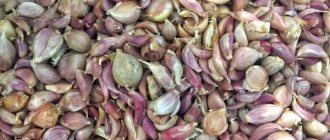- How to prepare potatoes for storage
- Creating suitable conditions for storing potatoes
- Potato storage: room characteristics
- Storing potatoes in winter: what you need to know
- General rules for storing potatoes and expert advice
- Conclusion
Every day, many people eat potato dishes: soup, mashed potatoes, baked goods and more. After all, potatoes are very tasty, filling and go well with other foods. For this reason, it is so important to know how to store potatoes at different times of the year - in an apartment or cellar, what container is best to choose for this vegetable and what storage conditions need to be created. Only in this case will it be possible to preserve the taste of the potatoes, and they will remain fresh and healthy.
Optimal conditions for storing potatoes in winter
Long-term storage requires certain environmental conditions.
Temperature
Long-term preservation of tubers is ensured by a temperature within +2...+4°C, which allows you to preserve the taste and appearance of vegetables for several months.
Reducing the temperature to 0°C helps convert the starch contained in potatoes into sugar, and the vegetable acquires a sweetish taste. With a stronger and more constant decrease in temperature, it freezes and deteriorates.
Warming “awakens” potatoes, and already at +7°C the tubers begin to germinate.
Humidity
The optimal air humidity level for storing vegetables is 70-85%.
Increased humidity will lead to mold, disease, and rot. A decrease leads to softness and flabby tubers.
Illumination
Potatoes are stored exclusively in a dark room. Light causes tubers to turn green, which is associated with the production of poisonous solanine.
Shelf life
Different varieties of vegetables have different shelf life. Early ripening potatoes can last up to 2-3 months in ideal conditions. Mid- and late-ripening varieties with yellow flesh last the longest.
The storage duration is affected by the size and condition of the tubers:
- the shortest shelf life for small, damaged and cut tubers;
- average shelf life (until mid-winter) for large, overgrown tubers;
- Undamaged medium-sized tubers are stored for a long time.
The shelf life of the vegetable will increase if the tubers are poured:
- crushed garlic;
- onion peel;
- stove ash.
Potatoes will not rot or spoil if you cover the tubers with leaves and plants containing bactericidal substances (phytoncides), for example:
- rowan leaves;
- elderberry;
- fern;
- tobacco;
- bitter wormwood;
- crushed garlic;
- pine or spruce branches.
Long-term storage of tubers is achieved by sprinkling them with chalk, shavings, straw or cut paper.
Neighborhood
It is not recommended to store most vegetables mixed together, but some of them benefit from being stored together.
One of the most successful solutions is to place the beets in boxes on top of the potato tubers. Beets will protect the tubers from the cold and protect against fungal infections by absorbing excess moisture.
Potatoes topped with ginger root also store well.
What other nuances need to be taken into account?
Organizing potato storage is a whole science. In addition to choosing the right place and creating optimal conditions, you need to know some of the subtleties of storing potatoes:
- Potatoes should not be kept next to other vegetables. It only tolerates proximity to beets.
- Tubers need to be sorted out from time to time, soft, rotten and with shoots removed. Otherwise, all the potatoes will spoil.
- Do not wash potatoes before storing, otherwise they will quickly rot.
- Wet potatoes must be dried naturally, placing the tubers at a distance from each other.
- When sprouts appear, the product should be eaten as quickly as possible before it softens and turns green.
- Different varieties of potatoes should be stored separately. The fact is that they all begin to deteriorate at different times, and deterioration is a spreading process. For example, early-ripening potatoes are usually stored until November. And if it is placed in one box for a long-term view, the entire harvest will deteriorate ahead of schedule.
Add a green apple, ginger root or a sprig of wormwood to the potatoes. These folk remedies help delay the germination of tubers and prevent rotting.
So, potatoes are usually stored in basements and cellars. Their conditions are considered the best. But you can arrange a suitable place inside the apartment. As an alternative to a cellar, a balcony, pantry, or space under the kitchen sink are often used. The main thing is to comply with all storage conditions: maintain the correct temperature, humidity, protect the tubers from light. Then the harvest will not spoil and will feed the whole family until spring.
Preparing potatoes for storage
Preparing tubers for long-term storage consists of two stages.
Treatment
Goal: eliminate “underground” diseases (ultraviolet radiation is destructive for most microorganisms), allow the tubers to ripen and heal minor damage.
Freshly dug potatoes are left to dry in the sun for 2-3 hours, after which they are transferred to the shade under a canopy and left for 2-3 weeks.
By the end of the treatment period, the temperature is gradually reduced to +2...+4°C.
Important! The entire treatment period should not expose potatoes to moisture. It is not washed and carefully protected from rain and dew.
During this period, the tubers are sorted and inspected several times, sick and affected vegetables are removed.
Cooling
Goal: identifying hidden diseases.
Dried potatoes are placed in a cool room (cellar, basement) at a temperature of +2...+4°C for 1 month. It is recommended to lay vegetables in 1-2 layers for easy access.
At least once a week, the tubers are inspected and damaged ones are removed.
Do tubers need to be processed before storage?
Potatoes that have gone through the preparation stages do not need additional processing. To exclude diseases, it is sprayed with antifungal biological products - “Baktofit” or “Fitosporin”.
How to preserve seed tubers in a cellar
To preserve the crop for a long time, certain conditions must be met.
- For potatoes, a temperature range of 3-5 °C is of great importance. At a higher temperature, the tubers will begin to germinate, at a lower temperature they will freeze and become unsuitable for consumption.
- The room should be dark to protect the tubers from the formation of solanine.
- A state of rest does not mean a suspension of metabolic processes - the tubers breathe and release moisture. To successfully store potatoes, good ventilation in the cellar is necessary. Humid air and drops of condensation provoke the development of rot.
- It is necessary to caulk all cracks in advance and take care of protection from rodents.
- It is best to sprinkle the floor in the cellar with sand - it partially absorbs excess moisture. Linoleum, cement, slate are unacceptable materials for covering the floor in the cellar, as they lead to the accumulation of moisture and promote the development of fungi.
The keeping quality of potato tubers directly depends on weather conditions, soil composition, applied fertilizers and other nuances of cultivation.
- Vegetables grown in cold, rainy weather will be twice as bad as crops harvested after a sunny, dry summer.
- To keep potatoes better, they should be planted on dry soils with a high sand content. Crops grown on loam are unlikely to last until spring.
- The quality of potatoes is affected by the fertilizers that were fed to the plants during the growing season. Excess nitrogen contributes to an increase in sugar content - such a product is susceptible to various diseases, rots quickly and is not suitable for storage.
- Late blight affects the quality of potato tubers.
Temperature
The most suitable temperature for storing potatoes (at any time of the year) is 2-3 degrees Celsius. At this temperature, it is at rest, that is, roots do not grow and nothing freezes.
If the temperature is higher, the tubers will begin to “wake up” and prepare for spring planting.
The process of “awakening” potato tubers:
The eyes are awakening.
- Sprouts are growing.
And in the peel (in the upper layer) solanine (a toxic substance) begins to accumulate. If the temperature is close to 0 degrees, this will significantly affect the taste of the potatoes. It will have a sweetish aftertaste that can spoil the taste of any dish.
This happens because starch turns into sugar at low temperatures, and slightly frozen potatoes begin to deteriorate very quickly.
Air humidity
Requirements for air humidity when storing potatoes:
- The optimal humidity should be ensured at the level of 80 - 85%; with such parameters, the tubers will not “dry out”, that is, they will not lose their weight during storage.
- In dry air, the taste of potatoes deteriorates, the tubers become dry and lethargic, and their juiciness disappears.
- If, on the contrary, the humidity in the vegetable storage is too high, then fungal diseases and rotting of root crops may occur.
We suggest you read: How to properly store carrots for the winter at home
Other
Conditions for storing potatoes:
- Ventilation must be provided.
- It is not allowed to cement the bottom of the vegetable storehouse or cover it with floorboards, linoleum and other similar materials, because moisture will easily accumulate and mold will gradually appear. It is best to fill the bottom with sand, or small crushed stone or pebbles (materials that absorb moisture well).
- Two weeks before storing tubers in a vegetable storehouse, it must be disinfected. After any treatment, the storage must be closed for two days and then thoroughly ventilated.
- Potatoes should not be exposed to direct sunlight; because of this, they will begin to accumulate toxic glycosides (turn green), and it will no longer be possible to eat them.
- This root vegetable does not have any “neighbors”; the only exception can be made for beets (it is better to place them on top of the potatoes) - this is a favorable “neighbor”.
Beets perfectly absorb excess moisture, but it does not harm this root crop. - If you have to remove rotten potatoes, then you need to remove not only one tuber, but also those that were lying nearby (with close contact, all nearby tubers are infected with infection, even if they look healthy outwardly).
- It is necessary to prevent various pests from entering the storage facility from the outside: rats, mice and slugs.
Difficulties in storing potatoes arise due to starch and water, which are contained in large quantities in the tubers.
Tuber response to temperature
Maintaining temperature is the main condition for long-term preservation.
Will potatoes freeze at minus 1?
Temperatures of -1°C are dangerous for tubers only with regular and prolonged exposure . If such a value is rare and short-term, there will be no noticeable consequences.
Minimum temperature for storing potatoes
If the air temperature does not drop below 0°C, the potatoes will not freeze. And not a single variety of vegetable can withstand minus values.
Frozen potatoes are suitable for eating, despite the sweetish taste.
What varieties of potatoes are best stored?
The keeping quality of potatoes depends on the starch content in it. A more stable product has a higher content of the substance. Potatoes that are yellow in the middle also store well. For winter storage, medium and late varieties are preferable. There are many such varieties. For example, Nevsky, Skarb, Slavyanka. If storage problems arise, choose varieties that are resistant to various diseases.
Early potatoes are not used for winter storage. They try to use it before November. Early potato varieties “Hozyayushka” and “Aurora” are stored for up to three months. Early potatoes are also stored for planting. There are varieties that are poorly stored and begin to rot: “Sineglazka”, “Dnepryanka”. They should be used as early as possible.
Where can you store potatoes?
The place for storing potatoes is selected according to many indicators.
In the pantry
The main advantage of storing in the pantry is easy and quick access to vegetables at any time.
External storage rooms located in non-residential premises (garages, outbuildings) are organized according to the principle of basements and cellars: they provide the required temperature and humidity.
In the basement
A basement located above the house protects it from freezing in winter, but quickly heats it up when it gets warm. Store potatoes in the basement in bags, boxes or nets.
In the cellar
A cellar with a constant temperature of about +4ºС is the most practical and popular way to store crops.
Vegetables in the cellar are mainly stored in boxes or in bulk.
For the winter, the cellar is insulated and the potatoes are covered with burlap.
On the balcony or loggia
Storing potatoes on a balcony or loggia is very popular - not everyone has additional space for the harvest, and a small amount of potatoes should always be on hand.
The temperature on the glazed balcony is close to ideal, but ventilation and thermal insulation are not provided there.
The main method of storage is in boxes or bags covered with a blanket or other warm things.
Heated and unheated balcony
A heated balcony is more convenient for storage if the air temperature on it is close to the desired values. If the air warms up to +7°C and above, the potatoes will germinate.
An unheated balcony with low winter temperatures in the region will require insulated storage. If the temperature rarely drops below 0°C, when freezing it is enough to cover the potatoes with a warm blanket.
Glazed or unglazed balcony
A glass balcony with adequate ventilation is preferable for storing tubers, provided they are not exposed to direct sunlight.
If the balcony is not glazed, there is a high probability that moisture (rain or snow) will get on the vegetables and freeze.
In a refrigerator
It is not recommended to store potatoes in a regular refrigerator - they will acquire a sweetish taste.
But using a “Khrushchev-era” refrigerator (a cabinet under the window) is the right decision: the air temperature in such a cabinet is always lower than in the apartment, but higher than outside.
The main disadvantage of such a storage location is its small volume.
In the corridor
The corridor in the apartment is not suitable for storing potatoes due to the high temperature - the tubers will begin to rot.
In a hole in the ground
The method is suitable for storing surplus potatoes until spring with a very large harvest. The bottom of the pit is covered with straw, tubers are placed on it, straw again, then covered with boards and covered with earth. When it gets cold, additional layers of straw and earth are poured on top. The downside is that it is difficult to access the product (you need to dig it out).
In the trenches
Potatoes are stored in trenches, the need for which will not arise until mid-spring - early summer.
The potatoes are laid out in layers and covered with damp soil at least 3 cm thick. When it gets cold, straw and soil are poured on top.
In the pile
A pile is a trench, fenced on both sides with boards, between which potatoes are poured. A thick layer of straw (from 0.5 to 1 m), earth (40-70 cm) and heat-insulating material is placed on top.
In cold weather, the piles are insulated with straw, snow or peat. When the temperature rises, the insulation is removed.
In the apartment
Potatoes do not store well in an apartment. How to store potatoes indoors? Choose places that will increase its shelf life by at least 1-2 weeks:
- where it’s cold - in front of the balcony, by the window, in the hallway;
- where it is dark - under the sink, in the pantry;
- where there is free space - in special cabinet drawers.
Why do potatoes turn green? Storage errors.
If potatoes are stored incorrectly, they may turn black, turn green, begin to sprout prematurely and rot. Most often the culprits are:
- wrong choice of variety;
- stocking of low-quality product;
- joint storage of potatoes and fruits;
- unsuitable temperature and humidity;
- non-compliance with storage periods.
The basic rule for any storage is periodic inspection of stocks and immediate removal of spoiled product from storage.
Video: storing potatoes
https://youtube.com/watch?v=8QaPMcV28Ck
What and how to store potatoes
The selection of containers is no less important for the preservation of potatoes.
In wooden boxes
The most common storage method, providing sufficient ventilation, easy access to the crop and sorting the tubers into 10-12 kg portions that are easy to carry.
Boxes should not be placed on the floor or close to walls or each other. The distance from the box to the floor and to the walls is at least 20 cm.
In plastic containers
Plastic storages for vegetables are equipped with ventilation holes and have convenient access to the contents. But potatoes are stored in such boxes for a short time - up to a month.
In heated boxes
An increasingly popular technological method for storing potatoes is a thermal container with a heating and temperature maintenance system. It has the shape of a box or backpack with electrical insulation. It is easy to maintain and preserves the harvest even at -40°C.
In natural fabric bags
In addition to providing ventilation, burlap protects the potatoes from sun damage and greening. But it does not protect against frost, rain and snow.
In bulk
The simplest storage method that does not require additional costs.
The main conditions are not too high a pile height and high-quality preparation of tubers: 1-2 rotten specimens caught in the middle of a pile will quickly ruin the entire harvest.
In grids
The advantages of storing potatoes in nets are the low cost of the material, the ability to easily monitor the condition of the tubers, and inaccessibility to rodents if they are suspended high above the floor.
However, the mesh does not protect the vegetable from frost and sunlight.
Tara
Potatoes are usually stored in well-ventilated boxes or bags:
- Wooden boxes made from planks
- Wooden containers for storing potatoes in a cellar or basement
- Plastic containers with “mesh” walls and bottom
- Boxes made of thick cardboard with holes
- Mesh bags
- Burlap bags
Potatoes are best stored in small portions, so it is preferable to choose small boxes (for 10 kg of potatoes) made from wooden slats. They are light, reliable, easy to carry vegetables in, and can be stacked one on top of the other to save space. In such a container it is easier to sort through the potatoes; they can be viewed through the cracks for the presence of rotten tubers. Thanks to the distances between the slats, air will always flow to the vegetables, and by placing the box on bricks or pallets, you will provide additional ventilation. You can make such a box with your own hands, using unnecessary boards, wooden planks, leftover lumber and even chipboard, fiberboard and OSB. The optimal width of the planks is 5 cm, length - 50 cm. You will also need triangular-shaped wooden blocks for better fastening of the sides. It is best to connect parts together with nails or self-tapping screws.
Do-it-yourself wooden box - saving money on buying packaging!
Drawing of a potato storage box
To store potatoes, they also buy plastic boxes, less often metal ones. The plastic container is very light, and the mesh walls and bottom provide good ventilation. As for metal ones, they are much more expensive and heavier; moving potatoes will not be easy due to the weight of the boxes themselves.
You can also store potatoes in large containers made from pallets or the same wooden slats. They are made angular or rectangular. A regular rectangular container can have a horizontal door at the bottom or a door. Thanks to this design, it is convenient to pick potatoes.
It is preferable to choose bags made of mesh. In such a container, the potatoes “breathe” and do not fog up. Thick polypropylene bags are strictly not allowed for long-term storage. They practically do not allow air to pass through and are only suitable for harvesting and transporting them.
Today you can buy a special thermal bag for storing vegetables on the balcony in winter. The top of the bag is made of thick tent fabric, and the inner warm layer is made of thick durable padding polyester. In addition to insulation, such a bag has electric heating, thanks to which the temperature inside is maintained within 1–7ºС even in the most severe frost. There are also thermal containers on sale, where the temperature is regulated by a special temperature sensor and never drops below 1ºC. Perhaps the only drawback of such packaging is its cost. We have already described above how to make a heated container with your own hands.
The most common container for storing potatoes - photo
A wooden box is the most common container for storing potatoes. A plastic box with a mesh bottom and walls. A container option for storing potatoes in the cellar.
Storing potatoes in a corner container as an alternative to storing them in bins You can store potatoes in bright colored mesh bags Thermal bag is an excellent solution for storing vegetables at low temperatures
How to protect from moisture and freezing
The storage room is pre-dried and disinfected with a concentrated solution of lime. Wooden boxes and shelves are treated several times with a strong solution of potassium permanganate and completely dried in the open air.
A hood or vent and thermal insulation help remove excess dampness.
To reduce the humidity of the room, a layer of lime and sand is laid on the floor, and the potatoes are covered with burlap or felt and covered with sawdust or straw.
How to prevent potatoes from sprouting during storage
Tubers begin to germinate when the temperature rises to +7°C. Accordingly, the room temperature should not rise to this value.
Important! The room is ventilated mainly at night, cooled with air conditioning or covered with ice.
It is also believed that the germination process will be stopped if you mix the tubers with mint leaves.
Conditions
Potatoes are an unpretentious crop, so there are no problems with their preservation. The most important factors for shelf life are:
- place;
- container;
- temperature;
- humidity;
- lighting.
Place
When the vegetables are sorted and selected, a place in the apartment is chosen where the tubers will be located. It should be kept away from heating devices and other perishable crops. The most common places where potatoes are harvested in an apartment are:
- storage rooms;
- balconies with glazing;
- dark cabinets with locking doors.
The location must be chosen based on the amount of potatoes. If you use a lot of it, then only a large storage room or balcony will do, if you have a cellar. It is convenient to keep no more than a couple of buckets of tubers in the closet.
Tara
The main point when selecting containers is its ventilation. It is imperative that air gets to the potatoes, otherwise they will dry out or rot. Most often it is stored in wooden boxes with slots. The top of the box can be covered loosely with a lid.
If the number of tubers is small, you can pour them into a plastic bucket, the bottom of which is lined with paper to protect it from moisture. It is allowed to store potatoes at home in plastic bags or bags, just do not tie them at the top.
Temperature
The lower the temperature, the longer the potatoes will be stored. The best option is to maintain the temperature at a level from plus 10 to 16 degrees. At higher temperatures, potatoes begin to soften, lose their taste and sprout. The germination process is especially active towards the end of spring.
Too low a temperature is also harmful to the tubers: they freeze and become tasteless. In addition, potatoes quickly spoil in the cold and are not suitable for food.
Lighting
A prerequisite for proper storage is the absence of daylight. You can store the tubers in a dark place for a long time, but if you put them in the sun’s rays, the skin wrinkles, and the fruits themselves lose some of their juice and become dry. The sun stimulates the awakening of the eyes, so shoots will soon appear on the tubers.
In the dark, the eyes “sleep” until mid-spring and only with warming do they awaken and grow over the surface of the vegetable.
Humidity
Select a place in the house for the culture so that the humidity is at a minimum level. 15-50% is enough for the potatoes to lie well. When humidity rises, rot occurs and spreads very quickly. Humid air also promotes the germination of eyes, which are not at all needed for storage and will only shorten its shelf life.











